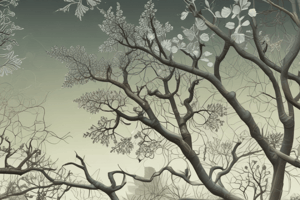Podcast
Questions and Answers
What is the main focus of microbiology?
What is the main focus of microbiology?
- Study of the structure and function of cells
- Study of the chemical processes that occur within living organisms
- Study of microorganisms, such as bacteria, viruses, and fungi (correct)
- Study of the interactions between organisms and their environment
What is the study of heredity, genes, and variation in organisms?
What is the study of heredity, genes, and variation in organisms?
- Genetics (correct)
- Molecular Biology
- Ecology
- Biochemistry
What is the term for the sequence of nucleotides that determines the amino acid sequence of proteins?
What is the term for the sequence of nucleotides that determines the amino acid sequence of proteins?
- Mendelian Genetics
- DNA Structure
- Gene Expression
- Genetic Code (correct)
Flashcards are hidden until you start studying
Study Notes
Branches of Biology
- Botany: Study of plants, including their structure, growth, evolution, and interactions with the environment.
- Zoology: Study of animals, including their structure, behavior, evolution, and interactions with the environment.
- Microbiology: Study of microorganisms, such as bacteria, viruses, and fungi.
- Ecology: Study of the interactions between organisms and their environment.
- Biochemistry: Study of the chemical processes that occur within living organisms.
- Molecular Biology: Study of the structure, function, and interactions of biological molecules, such as DNA, proteins, and carbohydrates.
- Genetics: Study of heredity, genes, and variation in organisms.
Cell Biology
- Cell Structure: Includes plasma membrane, cytoplasm, nucleus, and organelles such as mitochondria, ribosomes, and lysosomes.
- Cell Functions: Includes metabolism, photosynthesis, cell signaling, and cell division.
- Cell Cycle: Includes interphase, mitosis, and cytokinesis.
Genetics
- Mendelian Genetics: Study of how traits are inherited based on the laws of Mendel.
- DNA Structure: Double helix model, composed of nucleotides (A, C, G, and T).
- Genetic Code: Sequence of nucleotides that determines the amino acid sequence of proteins.
- Gene Expression: Process by which genetic information is converted into a functional product, such as a protein.
Evolution
- Theory of Evolution: Describes how species change over time through natural selection, genetic drift, mutation, and gene flow.
- Mechanisms of Evolution: Includes natural selection, genetic drift, mutation, and gene flow.
- Evidence for Evolution: Includes fossil record, comparative anatomy, and molecular biology.
Ecosystems
- Ecosystem Components: Includes biotic factors (living organisms) and abiotic factors (non-living environment).
- Energy Flow: Energy is transferred from one trophic level to the next through food chains and food webs.
- Ecological Interactions: Includes predation, competition, symbiosis, and decomposition.
Human Biology
- Human Body Systems: Includes skeletal, muscular, nervous, circulatory, respiratory, and digestive systems.
- Human Health: Includes prevention, diagnosis, and treatment of diseases, as well as human nutrition and wellness.
- Human Development: Includes embryonic development, growth, and aging.
Branches of Biology
- Botany studies the structure, growth, evolution, and interactions with the environment of plants.
- Zoology examines the structure, behavior, evolution, and interactions with the environment of animals.
- Microbiology focuses on microorganisms, including bacteria, viruses, and fungi.
- Ecology explores the interactions between organisms and their environment.
- Biochemistry delves into the chemical processes that occur within living organisms.
- Molecular Biology investigates the structure, function, and interactions of biological molecules, such as DNA, proteins, and carbohydrates.
- Genetics studies heredity, genes, and variation in organisms.
Cell Biology
- Plasma membrane, cytoplasm, nucleus, and organelles like mitochondria, ribosomes, and lysosomes make up cell structure.
- Cell functions include metabolism, photosynthesis, cell signaling, and cell division.
- The cell cycle consists of interphase, mitosis, and cytokinesis.
Genetics
- Mendelian Genetics explains how traits are inherited based on the laws of Mendel.
- DNA is structured as a double helix composed of nucleotides (A, C, G, and T).
- The genetic code determines the amino acid sequence of proteins through the sequence of nucleotides.
- Gene expression is the process by which genetic information is converted into a functional product, such as a protein.
Evolution
- The Theory of Evolution describes how species change over time through natural selection, genetic drift, mutation, and gene flow.
- Mechanisms of evolution include natural selection, genetic drift, mutation, and gene flow.
- Evidence for evolution is found in the fossil record, comparative anatomy, and molecular biology.
Ecosystems
- Ecosystems consist of biotic factors (living organisms) and abiotic factors (non-living environment).
- Energy flows through ecosystems from one trophic level to the next through food chains and food webs.
- Ecological interactions include predation, competition, symbiosis, and decomposition.
Human Biology
- The human body consists of skeletal, muscular, nervous, circulatory, respiratory, and digestive systems.
- Human health involves prevention, diagnosis, and treatment of diseases, as well as human nutrition and wellness.
- Human development encompasses embryonic development, growth, and aging.
Studying That Suits You
Use AI to generate personalized quizzes and flashcards to suit your learning preferences.




